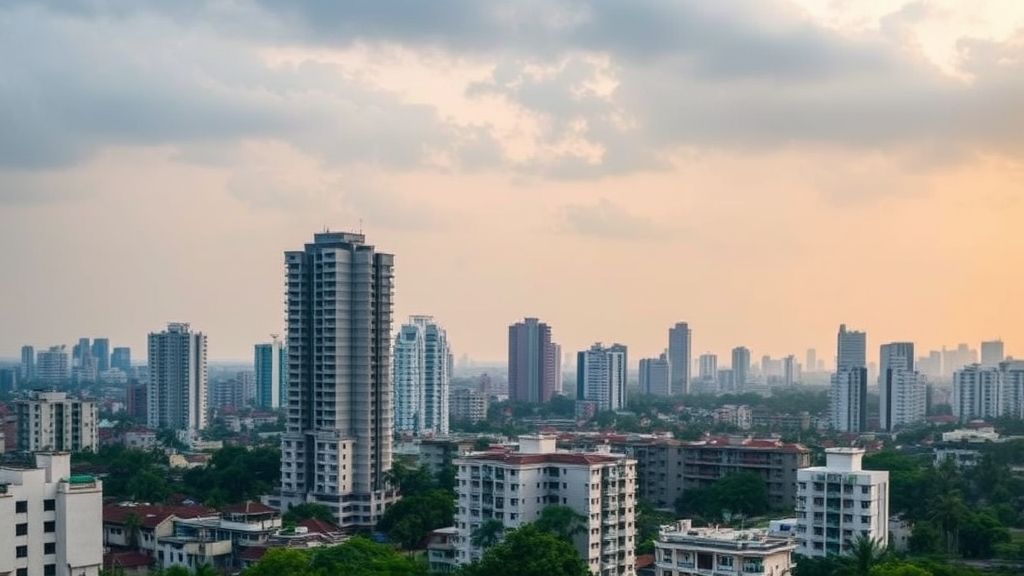Introduction
During the last decade, I have been living in a rented apartment in the region of the National Capital (NCR). As a tenant, I have no control over the walls or roof. Without the permission of the owner, I cannot simply hit a nail to hang a favorite paint, much less replacement with the walls. This lack of freedom caused a thought a few weeks ago: why not buy a small house or its own floor? After years of hard work and saving every penny, I assumed that I would have enough to pay a fashionable house in a bustling region like NCR. But the reality of the real estate market criticized my hopes. The high prices of the properties made it clear that not only could I not pay a direct floor, but even the monthly EMI for a mortgage loan was out of my reach. This experience led me to explore why a home remains an elusive dream for millions of Indians, particularly in urban areas.
The harsh reality of India’s real estate market
To understand the scale of the problem, I contacted friends who live in cities like Mumbai, Bengaluru and Pune. Their stories echoed mine, revealing a gloomy truth: 59% of the Indians believe they can never pay a home. The numbers paint a marked image. In Urban India, the average price to income ratio, a key measure of housing affordability, is 11. This means that to buy a house, the average person must spend 11 years on their annual income, save each penny. In the Mumbai Metropolitan Region, this proportion of heaven shoots at more than 14. For the context, a price-income ratio or 5 is comfortable. In contrast, developed nations such as the US (3.6), Australia (7.6) and Germany (9) offer much more affordable homes in relation to income.
For example, renting a space of 6 × 3 feet (equivalent to a single bed) in a city like NCR costs around ₹ 11,000 per month, translating into an internship of ₹ 2 Lakh annually. A modest 1bhk floor of 400 square feet could delay ₹ 44 Lakh. For the average Indian, these figures are astronomical, which forces many to trust home loans. However, even with a loan, the monthly EMI or consumes 61% of a person’s income, which makes it unsustainable for most.
Why are properties prices so high?
The root cause of real estate prices in urban India lies in the basic economic principle of supply and demand. As the urban population of India grows rapidly, the demand for housing in cities far exceeds the supply. Metropolitan cities such as Mumbai, Delhi and Chennai are densely populated, with limited lands available for residential development. For example, Hyderabad has had more than 18,000 people per square kilometer, while Delhi has more than 11,000. This high population density creates intense competition for limited homes, which drives prices up.
In addition, urban infrastructure has failed to maintain population growth pace. Most people because houses near officials, schools or markets, but densely populated areas cannot accommodate everyone. This leads to a scenario of “a fruit, one hundred buyers”, where buyers are willing to pay exorbitant prices to ensure property. Between 2020 and 2024, properties prices in the 10 main cities of India grew at an annual compound growth rate (CAGR) or 9.3%, while revenues grew to a single 5.4%. Around the last three decades, housing prices have increased 15 times, far exceeding income growth.
Structural problems in the real estate market
Beyond supply and demand, several structural problems exacerbate the affordability crisis:
1. Floor low space index (FSI)
The urban planning regulations of India, in part, the floor space index (FSI), limit the height of the buildings. FSI determines how many floors Ben can build on a plot of land. In Mumbai, FSI varies from 1.33 to 5, and in Delhi, it is between 1.2 and 3.5. Compare this with New York (15), Tokyo (20) or Singapore (25), where the highest FSI allows skyscrapers that maximize the use of the earth. The low FSI of India restricts vertical expansion, which leads to a shortage of housing units. From 2024, India has only 122 skyscrapers, compared to 3,300 in China and almost 900 in the United States.
While the government argues that the FSI under avoids the excessive concentration of the population and explains the seismic risks, experts call these outdated excuses. They advocate the construction codes and city planning to increase the FSI, which could make homes more affordable by increasing supply.
2. inefficient policies of land use
The reports of the Center for Social and Economic Progress (CSEP) and the India Infrastructure Report 2023 highlight the policies of defective land use. Many Indian cities lack master plans, which leads to unplanned and non -scientific urban growth. The former CEO of Niti Aayog Amitabh Side has indicated that more than half or the legal cities of India grow without an adequate infrastructure guide. This makes it a challenge for developers to plan and finance residential projects, in addition to supply.
3. Missing or transparent data
The absence of credible data on the use of the land and the obstacles of the assignment of effective properties in the planning of the city. Without clear information about which land is designated for residential, commercial or government projects, developers and buyers face uncertainty. This lack of transparency allows some dominant actors in the market to control the real estate sector, the prices of artificial inflate. A December 2024 study revealed that approximately 1 million housing units remain without selling, since developers retain the issue to keep high prices.
4. Black money and market manipulation
The real estate market of India has long been a refuge for black money. Buyers and vendors often transaccan part of the cash payment to evade taxes. For example, an ₹ 1 crore floor could have a circle rate (a minimum price established in the government) or ₹ 40 Lakh. The buyer pays an ₹ 40 Lakh official and the ₹ 60 Lakh cash linen, reducing the tax burden for both parties. This practice inflates properties prices and makes the market less affordable for honest buyers. In addition, Benami Properties (bought under false names) are used to park black money, further distorting the market.
The emotional and cultural value of the home of origin
In India, having a home, more than a financial decision: it is a cultural and emotional milestone linked to social respect and prestige. From NRI high height in the low middle class, everyone aspires to own a house. A report from the Bank of the India Reserve indicates that Indian households invest 77% of their total real estate assets, compared to 62% in China and 44% in the United States. This emotional attachment drives people to stretch beyond their financial means, exacerbating demand supply imbalance.
The Covid-19 pandemia further intensified this desire. Work arrangements from home increased savings for some, while market uncertainties stressed the need for a stable house. After 2020, the demand for own homes increased, which increases prices even more.
Can the government close the gap?
The Government has introduced measures such as the Indian Digital Land Registration Modernization Program and linking AADHAR with land documents to stop black money and improve transparency. However, its effectiveness remains uncertain. Experts suggest that increasing the FSI, the review of the construction codes and improving city planning could significantly boost the supply of housing and affordability. The World Bank has criticized the FSI regulations of India as irrational, arguing that they hinder economic growth.
Conclusion
For millions of urban Indians like me, the dream of owning a house feels increasingly out of reach. Property prices, driven by limited supply, defective policies and market manipulations, have created a real estate market that is unbeatable for the average person. While cultural and emotional factors combined demand, structural problems such as low FSI, poor urban planning and black money maintain high prices. Until the thesis challenges are addressed, the aspiration of housing property will continue to be a distant dream for many. If you face similar struggles in your city, share your thoughts: what is the real estate market where you live?

